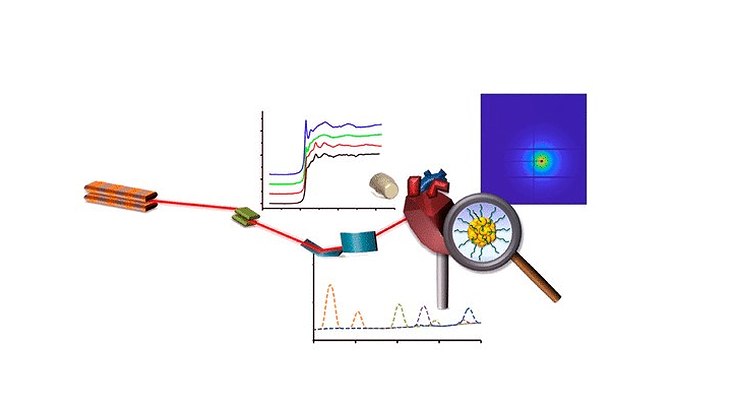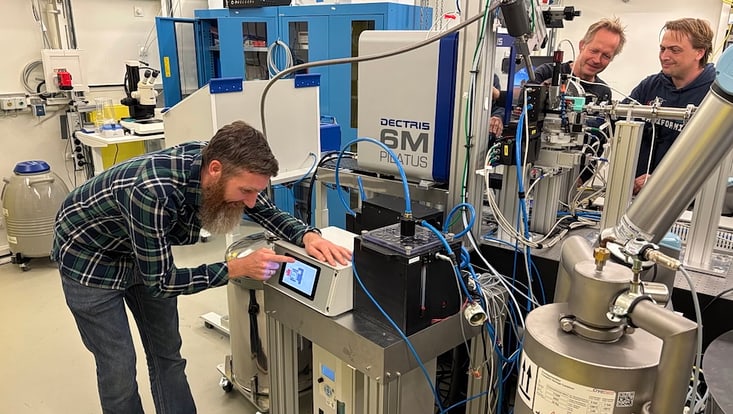Imaging of Matter
Perspectives of synchrotron radiation in biology
10 March 2021

Photo: American Chemical Society
What could be done with X-rays, in particular synchrotron radiation, for biologically motivated experiments? What are the opportunities and perspectives for the future? An international team of scientists including many researchers from Universität Hamburg and the Cluster of Excellence “CUI: Advanced Imaging of Matter” share their views in a joint article in the scientific journal ASC Nano. The discussion is predominantly guided by asking how X-ray-based methods could better help to understand and to improve nanoparticle-based drug delivery.
X-ray-based analytics are routinely applied in many fields, including physics, chemistry, materials science, and engineering. The full potential of such techniques in the life sciences and medicine, however, has not yet been fully exploited. The researchers highlight current and upcoming advances in this direction. They describe different X-ray-based methodologies including those performed at synchrotron light sources and X‑ray free-electron lasers and their potentials for application to investigate the nano−bio interface. They also discuss current limitations and how they might be overcome, particularly for future use in vivo.
“The special thing of our article is that visions are given, what might be possible in the future, though still not today”, says Prof. Wolfgang Parak from the Department of Physics at Universität Hamburg. For example, the researchers expect improvements in the development of X-ray light sources which will enable their use for biological/medical experiments that have not yet been feasible. Due to their high X-ray absorption cross sections and their potential conjugation with drugs, inorganic nanoparticles are an important part of the molecular and nanoscience toolkits for exploiting such developments. The authors also anticipate an increase in the uses of X-ray techniques to explore the fates and mechanisms of therapeutic nanomaterials. They further expect applications to experiments in laboratory, preclinical, and clinical environments, as large efforts are currently directed to developing improved compact X-ray sources. And they foresee that X-rays will have important, fundamental roles in the advance of nanomedicine toward its maturity over the next decades.
“The article brings together different fields of expertise and in this way also demonstrates very nicely what our cluster stands for”, Parak says. “The result is a condensed joint work and a broad overview which I hope it is of interest to people who want to know what one can and could do with synchrotron radiation in biology.”
Publication:
C. Sanchez-Cano, R.A. Alvarez-Puebla, J. M. Abendroth, T. Beck, R. Blick, Y. Cao, F. Caruso, I. Chakraborty, H. N. Chapman, Ch. Chen, B. E. Cohen, A. L. C. Conceicão, D. P. Cormode, D. Cui, K. A. Dawson, G. Falkenberg, Ch. Fan, N. Feliu, M. Gao, E. Gargioni, C.-C. Glüer, F. Grüner, M. Hassan, Y. Hu, Y. Huang, S. Huber, N. Huse, Y. Kang, A. Khademhosseini, Th. F. Keller, Ch. Körnig, N. A. Kotov, D. Koziej, X.-J. Liang, B. Liu, S. Liu, Y. Liu, Z. Liu, L. M. Liz-Marzán, X. Ma, A. Machicote, W. Maison, A. P. Mancuso, S. Megahed, B. Nickel, F. Otto, C. Palencia, S. Pascarelli, A. Pearson, O. Peñate-Medina, B. Qi, J. Rädler, J. J. Richardson, A. Rosenhahn, K. Rothkamm, M. Rübhausen, M. K. Sanyal, R. E. Schaak, H.-P. Schlemmer, M. Schmidt, O. Schmutzler, Th. Schotten, F. Schulz, A. K. Sood, K. M. Spiers, Th. Staufer, D. M. Stemer, A. Stierle, X. Sun, G. Tsakanova, P. S. Weiss, H. Weller, F. Westermeier, M. Xu, H. Yan, Y. Zeng, Y. Zhao, Y. Zhao, D. Zhu, Y. Zhu, and W. J. Parak
“X‑ray-Based Techniques to Study the Nano−Bio Interface”
ASC Nano XXXX, XXX, XXX−XXX (2021, in press)


